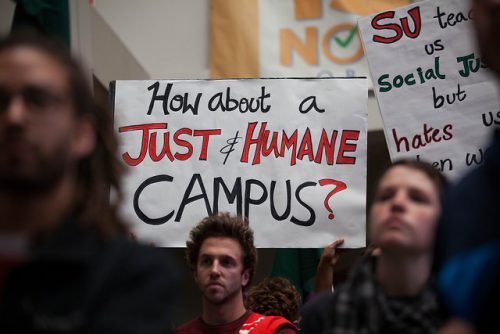College and university administrations are facing new waves of union organizing that look different from traditional labor organizing and pose new sets of challenges. If a union drive comes to a college or university in your coverage area, here’s some background and resources for covering it.
Graduate student organizing
One prominent area of growth in campus union organizing is among graduate students with paid research and teaching assistantships. These students work for the university researching projects or as teaching assistants for faculty while also pursuing studies toward their advanced degree. Advocates for graduate student unionization argue the rising cost of tuition and fees at educational institutions, coupled with the limited compensation and health care options offered to graduate assistants, make it difficult for students to make ends meet. Many university and college officials note that the relationship between graduate students and academia is more complicated than a typical employer-employee relationship and question if unionization is the right answer to those challenges.
Though there are a number of graduate student union locals (the majority at public institutions), the first hurdle that these students face is to be classified as “workers” in the first place.
The National Labor Relations Board is set to review issues surrounding the organizing of graduate students at private institutions. Collective bargaining rights at public schools are determined by their state’s labor laws, but the NLRB makes decisions that impact private institutions. Look into your state’s labor laws to see if student employees have collective bargaining rights. If graduate students are organizing at a private school in your community, the future NLRB ruling will have an impact.
For context in your reporting, learn about graduate student organizations recognized by colleges or universities near you. The Coalition of Graduate Employee Unions hosts an online directory with contact information for these groups. The organization also tracks non-recognized graduate student unions and ongoing organizing campaigns.
For information on the graduate student population or to understand the potential impact of unionization in your state, you can reference the Council of Graduate Schools database, which breaks down demographic information of graduate students.
Adjunct Faculty Organizing and the Fight for $15
Graduate students aren’t the only members of the higher education community looking for better compensation and benefits. Adjunct faculty have notably joined the Fight for $15 rallies in cities and states across the country. Advocates say they’re hoping to shift the conversation about faculty pay in the ways fast food workers did about the minimum wage in recent years. Some adjuncts who are active in the campaign are calling for pay of $15,000 per course, a leap from the $2,000-3,000 per course many report they’re currently offered.
For more information about the nationwide campaign that adjunct faculty are leading, check out the Service Employees International Union-backed Faculty Forward Network. The network produces stories, data and campaign information you can use as you report on what’s happening locally.
Additionally, there’s been a noted shift in the hiring of adjunct faculty in colleges and universities as opposed to tenure-track full-time faculty. The Delphi Project, a coordinated effort between the American Association of University Professors and the University of Southern California, provides resources for colleges and universities to assess the makeup of faculty and understand their impacts on academia. Reports from the project can be useful to reporters as well and are available online, such as one about the changing trends of faculty employment status.
Also be sure to look into what university officials say about adjunct pay. How are these payments calculated and budgeted? How do shifting employment trends at the school compare to national ones and how might changes to faculty pay affect the university budget or even tuition, as rising costs affect other stakeholders?
Athletes and the NLRB
Last year, college sports was at the center of union organizing, as Northwestern football players sought collective bargaining rights and held a union vote. But after an appeal by the university and the NCAA, the NLRB declined to weigh in with a decision that could have allowed football players to do so as employees of the school. The NLRB declined to “assert jurisdiction,” meaning it didn’t weigh in, because unlike Northwestern the majority of NCAA teams are public institutions. Any precedent it set would only affect some college ball teams. The board said the move could destabilize the labor relations for other NCAA teams.
But as the debate about the perks and benefits universities and colleges should or could offer student athletes continues, the question of whether or not they’re “employees” may be reviewed in the future if a union drive occurs at another program or a different-sized college team.










